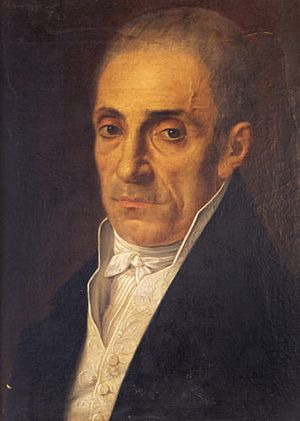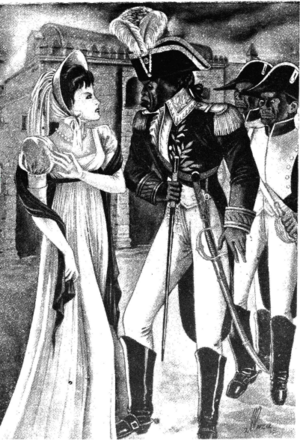Juan Sánchez Ramírez facts for kids
Juan Sánchez Ramírez (1762–1811) was a brave Dominican soldier. He served as the Captain General (a top military leader and governor) of what is now the Dominican Republic from 1808 to 1811. He also led the troops that fought against French rule in the Santo Domingo colony. In 1808 and 1809, he commanded forces in the Battle of Palo Hincado. This battle resulted in a big victory over the French. It helped return Santo Domingo to Spanish control.
Quick facts for kids
Juan Sánchez Ramírez
|
|
|---|---|
 |
|
| Governor of the Spanish Colony of Santo Domingo (1809-1821) | |
| In office December 13, 1808 – February 11, 1811 |
|
| Succeeded by | Manuel Caballero y Masot |
| Personal details | |
| Born | 1762 Cotuí, Captaincy General of Santo Domingo (later the Dominican Republic) |
| Died | February 11, 1811 ?? |
| Nationality | Dominican and Spanish |
| Residences | Santo Domingo, Puerto Rico (1803–1807) |
| Profession | Politician and Captain general |
| Military service | |
| Allegiance | |
| Branch/service | |
| Rank | |
| Battles/wars | Reconquest of Santo Domingo |
Contents
Biography
Early Life and Challenges
Juan Sánchez Ramírez was born in 1762 in Cotuí, a town in the Spanish colony of Santo Domingo. His father was a Spanish military member and a rich landowner. A priest named Pichardo y Delmonte helped with his education. When he was young, he led a group of lancers (soldiers with spears) from Cotuí.
Ramírez held important jobs in Cotuí, including being a local official called a magistrate.
In 1801, a Haitian revolutionary leader named Toussaint Louverture took control of Santo Domingo from France. He also freed the remaining enslaved people there. In 1802, France sent a large army to the island. These soldiers defeated Toussaint and took back control. However, the Haitians and French took over lands belonging to Juan Sánchez Ramírez and many other Spaniards.
Because of these changes, Ramírez moved to Puerto Rico in December 1803.
The Battle of Palo Hincado
In July 1807, while still in Puerto Rico, Ramírez learned that Spain had declared war on France. He decided to act. Ramírez gathered about two thousand men from Cuba, Puerto Rico, and England. He then traveled to the eastern part of Santo Domingo.
There, he encouraged local people to fight against the French. He wanted them to join him in the Reconquest of Santo Domingo. Many landowners and loggers joined his army. Ramírez also stayed in touch with the Captain General of Puerto Rico, Toribio Montes. Montes gave him official permission and promised military and financial help.
In early November 1808, 300 soldiers from Puerto Rico joined Ramírez's forces. Ramírez marched towards the city of Santo Domingo. On December 13, 1808, he returned to the city with his troops. He led British and Haitian armies against French rule in the Battle of Palo Hincado. They defeated the French and drove them out of Santo Domingo.
After this big French defeat, Spain regained control of Santo Domingo. Ramírez was then appointed as the Governor of the colony. The area became known again as a Captaincy General.
Governing Santo Domingo
As governor, Sánchez Ramírez called a meeting called the Board of Bondillo. This board created new laws. It also canceled an old agreement called the Treaty of Basel. This confirmed that Santo Domingo would stay under Spanish control. Ramírez officially declared Santo Domingo Spanish in July 1809.
Under his leadership, Santo Domingo began trading again with countries allied with Spain. The Universidad Santo Tomás de Aquino (UASD), a university, was also reopened.
He stopped the French government's practice of taking people's property. He also allowed British ships to trade in Santo Domingo's ports.
However, Ramírez brought back a system where people were forced to work without pay. This system had been ended by the Haitians. As a result, many people in Santo Domingo became very poor. Several attempts were made to overthrow Sánchez Ramírez's government. People who rebelled faced harsh punishments. Some were even sent far away to a place called Ceuta.
Ramírez also tried to improve the economy of the Dominican Republic. But Spain was busy fighting wars against its colonies in South America. His time as governor led to a period known as España Boba (Foolish Spain). During this time, Ramírez's government punished anyone who supported or fought for the colony's independence.
Ramírez became ill and died on February 11, 1811, at the age of fifty. He was still governing the colony when he passed away. He was buried in the National Pantheon.
Personal Life
Juan Sánchez Ramírez eventually became a landowner. He married Josefa del Monte y Pichardo. They had two children, Juana and José. In Santo Domingo, Ramírez lived on Padre Billini Street. After he died, his family, who were said to be poor, moved to San Carlos. His widow often said that he had many important jobs but never received a salary.
Legacy
- A street in Santo Domingo is named after him.
See also
 In Spanish: Juan Sánchez Ramírez para niños
In Spanish: Juan Sánchez Ramírez para niños
- History of the Dominican Republic
- Captaincy General of Santo Domingo
- Era de Francia
- Spanish reconquest of Santo Domingo
- List of colonial governors of Santo Domingo
- España Boba
- Republic of Spanish Haiti
- Haitian occupation of Santo Domingo
- José Núñez de Cáceres
- Juan Pablo Duarte
- Francisco del Rosario Sánchez
- Matías Ramón Mella


